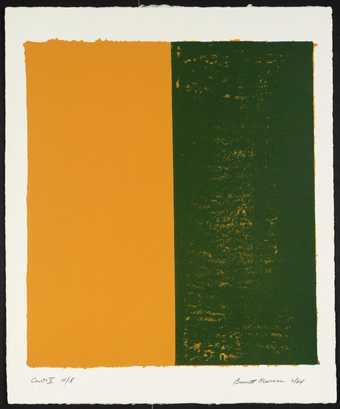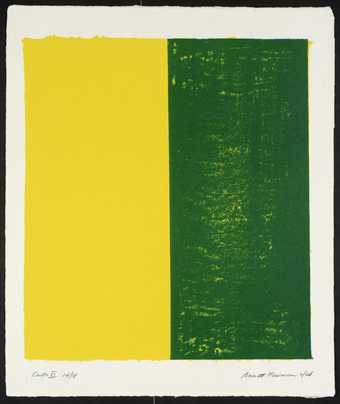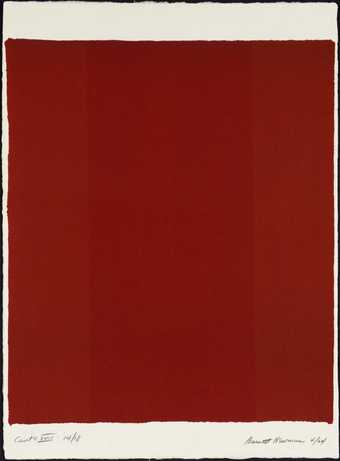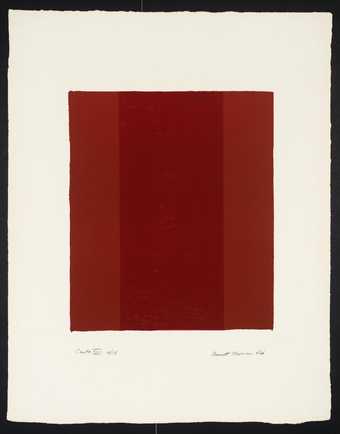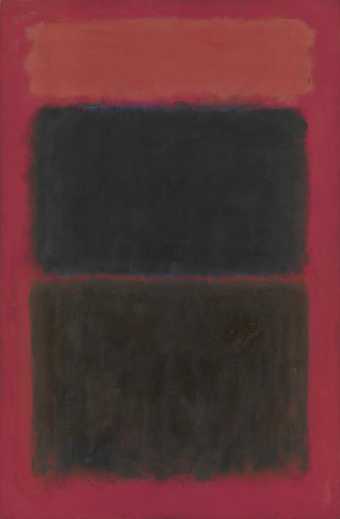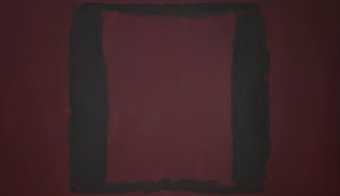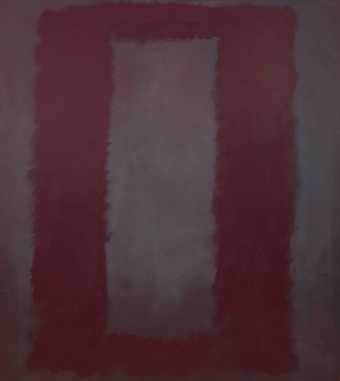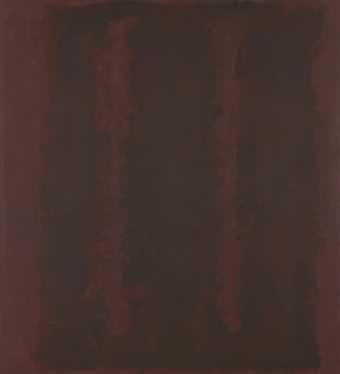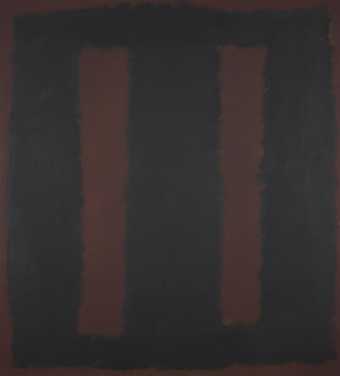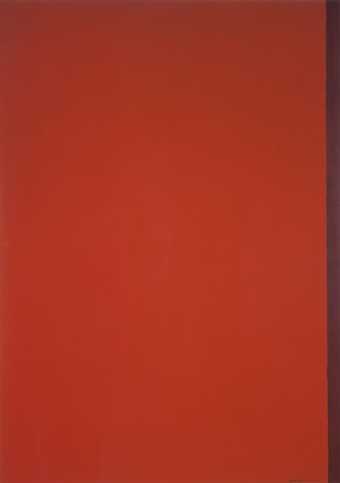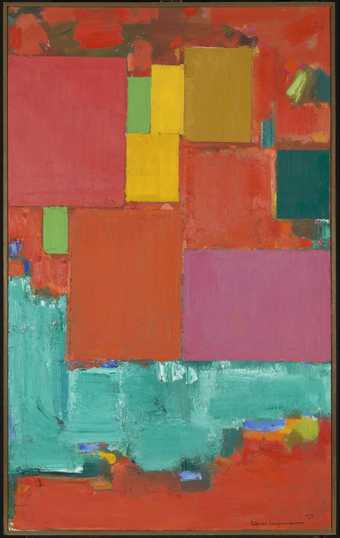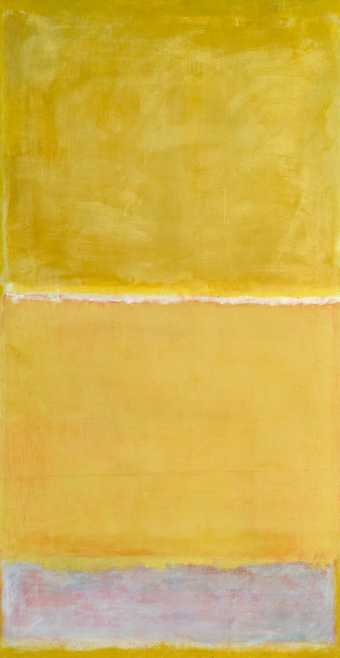
On loan
National Art Center (Tokyo, Japan): Light
- Artist
- Barnett Newman 1905–1970
- Medium
- Oil paint on canvas
- Dimensions
- Support: 2429 × 2029 mm
- Collection
- Tate
- Acquisition
- Purchased 1968
- Reference
- T01091
Display caption
From the mid-1940s Newman had been preoccupied with the Jewish myths of Creation. The vertical strips in his paintings may relate to certain traditions that present God and man as a single beam of light. The name Adam, which in the Old Testament was given to the first man, derives from the Hebrew word adamah (earth), but is also close to adom, (red) and dam (blood). The relationship between brown and red in this painting may therefore symbolise man's intimacy with the earth.
Gallery label, August 2004
Does this text contain inaccurate information or language that you feel we should improve or change? We would like to hear from you.
Technique and condition
Painted on cotton duck, this painting has a traditional construction. The fabric is tacked to an expandable stretcher. It is sized then primed with white oil paint. The artist laid in a thin wash of crimson oil paint, then, when dry, using masking tape, marked out two crimson stripes, one to the far left and the other a thin strip on the right. Brown paint was brushed evenly over the crimson up to the tape and then clarified with a knife to form a crisp burred edge. The crimson stripe was deepened in a similar manner, by masking off the brown paint with tape. However, the tape did not stick well to the partially dry oil paint and red brush strokes escaped beneath the tape onto the brown, leaving a flickering edge. Taking more brown paint, the artist re-defined the edge by cancelling the renegade strokes.
One year later, Barnett Newman altered the composition by adding a central red stripe. In preparation, the brown paint was rubbed down, in some places down to the cotton canvas, now apparent only through slight differences in texture. A red stripe was painted on top using the same technique as before. The new stripe is slightly glossier than the rest of the painting which exhibits subtle differences in sheen across the surface.
The painting is unvarnished. Originally the edges were probably covered by pale brown tape. The painting is unframed.
The painting is in good condition. Careful handling helps to protect the delicate surface while the use of a storage frame enables the painting to be protected when not on display.
Mary A. Bustin
July 1999
Catalogue entry
Barnett Newman 1905-1970
T01091 Adam
1951-2
Inscribed 'Barnett Newman | 1951 + 52' b.l. and 'ADAM', '[arrow pointing upwards] TOP | Barnett Newman | 1951 | + 52', '[arrow pointing upwards] TOP | Barnett Newman | 1951 + 52 | "ADAM"' on back of canvas
Oil on canvas, 95 5/8 x 79 7/8 (243 x 203)
Purchased from Mr and Mrs Ben Heller (Grant-in-Aid) with the aid of a donation from S. Herbert Meller through the American Federation of Arts 1968
Prov:
Mr and Mrs Ben Heller, New York (purchased from the artist 1957)
Exh:
Barnett Newman, Betty Parsons Gallery, New York, April-May 1951 (no catalogue); Die neue amerikanische Malerei, Kunsthalle, Basle, April-May 1958 (54, repr.); La Nuova Pittura Americana, Galleria Civica d'Arte Moderna, Milan, June 1958 (54, repr.); La Nueva Pintura Americana, Museo Nacional de Arte Contempor neo, Madrid, July-August 1958 (53); Die neue amerikanische Malerei, Hochschule für bildende Kunste, Berlin, September-October 1958 (54, repr.); Jong Amerika Schildert, Stedelijk Museum, Amsterdam, October-November 1958 (54); La Nouvelle Peinture Américaine, Palais des Beaux-Arts, Brussels, December 1958-January 1959 (54, repr.); Jackson Pollock et la Nouvelle Peinture Américaine, Musée National d'Art Moderne, Paris, January-February 1959 (53); The New American Painting, Tate Gallery, February-March 1959 (53, repr.); The New American Painting, Museum of Modern Art, New York, May-September 1959 (53, repr. in colour); The Collection of Mr and Mrs Ben Heller, Museum of Modern Art exhibition circulating in the USA, 1961 (works not numbered, repr. in colour); Barnett Newman, Museum of Modern Art, New York, October 1971-January 1972 (35, repr. in accompanying book by Thomas B. Hess, cf. below); Stedelijk Museum, Amsterdam, March-May 1972 (30, repr.); Tate Gallery, June-August 1972 (30, repr.); Grand Palais, Paris, October-December 1972 (30, repr.); Untitled 25.10.73, Ashmolean Museum, Oxford, October-December 1973 (no catalogue)
Lit:
Thomas B. Hess, Barnett Newman
(New York 1969), p.66; Thomas B. Hess, Barnett Newman
(New York 1971), pp.48, 52, 56-7, 78, 80, 82-5, 92, repr. p.79
Repr:
Art in America, XL, No.2, 1960, p.52 in colour; The Tate Gallery
(London 1969), p.182 in colour
The last two paintings that Newman completed before his second one-man exhibition at the Betty Parsons Gallery in April-May 1951 were 'Eve' (coll. E.J. Power, London [subsequently Tate Gallery T03081]) and this picture called 'Adam'. At that time 'Adam' only had two stripes: the soft-edged reddish stripe down the left-hand side and the narrow 'zip' down the right. However in the following year Newman added the broad heavy red stripe down the left centre, which bends slightly towards the bottom. As a result the picture was given the double dating 1951 + 52.
'Eve', which is dated 1950, is a slightly narrower painting 172.5cm wide which has a field of bright red interrupted only by a narrow hard band of purple down the right-hand edge. The two pictures therefore do not have a great deal in common apart from the fact that both have bands at the sides, and Newman does not seem to have thought of them as pendants.
When asked by David Sylvester in a taped interview of 1967 to explain the significance of his titles such as 'Adam', Newman replied that his works were titled after they were completed but that he tried to choose a title which evoked the emotional content, a kind of metaphor which had some correspondence to the feeling of the picture.
'Adam' was one of a number of Old Testament titles that he used from about 1946 onwards. Having started to paint fluently again after an interruption of some five years, and trying to make a fresh start and re-think painting again from the beginning, he tended to choose titles relating to the act of creation ('The Beginning', 'Genetic Moment'), Old Testament prophets ('Abraham', 'Joshua') and so on. Adam as the first man was in keeping with this. At the same time the word 'adam' also means in Hebrew man or mankind and derives from the word 'adamah' meaning earth. The Hebrew word 'adom' means red. Thus there is a connection with the two colours in the painting, earthy brown and red. Annalee Newman confirmed to the compiler in June 1972 that she had heard her husband talk about the word 'adam' and the Hebrew meanings red and earth, but that he had never discussed these with her in relation to the painting. It would appear, as Thomas B. Hess has pointed out, that his titles often had hidden meanings which were intended to hint at mystical religious experiences and Kabbalist thought.
Mrs Newman said that Ben Heller, the first owner of this painting, was introduced to Newman by Jackson Pollock. He bought 'Adam' and 'Queen of the Night I' direct from the studio in 1957. 'Vir Heroicus Sublimis' was bought later.
Published in:
Ronald Alley, Catalogue of the Tate Gallery's Collection of Modern Art other than Works by British Artists, Tate Gallery and Sotheby Parke-Bernet, London 1981, pp.556-7, reproduced p.556
Explore
- abstraction(8,615)
-
- non-representational(6,161)
- formal qualities(12,454)
-
- light(150)
- Bible: Old Testament(381)
-
- Adam(62)
- Judaism(1,186)
You might like
-
Barnett Newman Canto X
1963–4 -
Barnett Newman Canto XI
1963–4 -
Barnett Newman Canto XVII
1963–4 -
Barnett Newman Canto XVIII
1963–4 -
Mark Rothko Light Red Over Black
1957 -
Mark Rothko Black on Maroon
1959 -
Mark Rothko Red on Maroon
1959 -
Mark Rothko Black on Maroon
1958 -
Mark Rothko Red on Maroon
1959 -
Mark Rothko Black on Maroon
1958 -
Barnett Newman Eve
1950 -
Hans Hofmann Pompeii
1959 -
Mark Rothko Untitled
c.1950–2 -
Hans Hofmann Nulli Secundus
1964 -
Barnett Newman Moment
1946

